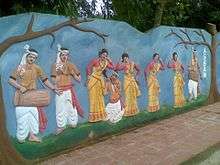Bihu dance
|
| |
| Genre | Folk |
|---|---|
| Origin | Assam, India |
The Bihu dance (Assamese: বিহু নৃত্য, Hindi: बिहू नृत्य) is a folk dance from the Indian state of Assam related to the Bihu festival. This joyous dance is performed by both young men and women, and is characterized by brisk dance steps,and rapid hand movement. Dancers wear traditionally colorful Assamese clothing.
Though the origins of the Bihu dance is unknown, the first official endorsement is cited to be when Ahom king Rudra Singha invited Bihu dancers to perform at the Ranghar fields around 1694[1] on the occasion of Rongali Bihu.
Description
The Bihu is a group dance in which males and females dance together but maintain different gender roles. In general, females follow stricter line or circle formations. The male dancers and musicians enter the dancing area first, and they maintain their lines and follow synchronized patterns. When the female dancers enter later the male dancers break up their lines to mingle with the female dancers, who maintain their stricter formations and order of the dance. The dance is usually characterized by definite postures; movements of the hips, arms, wrists; twirls, squats and bends but no jumps. Male and female dance movements are very similar, with only minor but subtle differences.
Performance

The dance is performed in accompaniment with traditional Bihu music. The most important musicians are the drummers (dhulia), who play a particular twin-faced drum, the dhol, slung from the neck and played with one stick and a palm. There are usually more than one dhulia in a performance, and they play different rhythms and compositions at different sections of the performance. These rhythmic compositions, called seus, are traditionally codified. Before entering the dancing area, the drummers play a short and brisk rhythm. The seu is changed and usually the drummers enter the dance area in line. The mohor xingor pepa is played generally in the beginning by a single player who lays out an initial plaintive motif and that sets the mood for the dance. The male dancers then enter the area in formation and perform accompanied by singing, in which all participate. Some other instruments that accompany this dance are the taal, a type of clash cymbal; the gogona, a reed and bamboo instrument; the toka, a bamboo clapper; and the xutuli, a clay whistle. Bamboo flutes are also often used. The songs (bihu geet) that accompany the dance have been handed down for many generations. The subject of the lyrics ranges from welcoming the Assamese new year to describing the daily life of a farmer, from historical references of invasions to Assam to contemporary socio-political commentary in a satirical way. Though both males & females perform Bihu dance, but female performed bihu dance has more variations. There are many stages in female performed Bihu dance — freehand, twisting, with rhythm pepa blowing, with Kahi (disk), with Jaapi (Assamese headgear) etc. The performance itself could be long, it is enlivened by rapid changes in rhythm, mood, movements, pace and improvisation; and dancers and musicians are given short opportunities to show their virtuosity.most of us we donot know real story of bihu dance it is an epitomic dance practice done by both male and female.
Forms of Bihu dance
The dance takes several forms among the different northeast Indian groups, e.g. "Deori Bihu dance", "Mising Bihu dance" etc. However, the underlying goal of the dance remains the same: to express the desire to feel both pain and happiness..
Rongali Bihu competitions
In mid April, along with the onset of spring, falls the new year in the local calendar with the month of Bohag. Nowadays, during this period, there are Bihu competitions all over the Assam (as well as throughout the major locations with Assamese diaspora. These competitions attract visitors and locals alike in huge throngs. Apart from Bihu dance, there are competitions held to select the Bihu Kunwori (Bihu Princess) and various singing talents.
At the end of the month of Bohag there is also the farewell to the month commemorated by numerous Bohagi Bidai functions.
See also
Notes
References
- TOI (2011-05-05), "Scholar throws light on Bihu's origin", The Times of India, retrieved 2011-05-30
External links
| Wikimedia Commons has media related to Bihu dance. |
- A sample of a Bihu dance performance, from youtube.com.
- Other Indian Folk Dances of Various parts of India.
- Rati Bihu : A kind of bihu dance celebrated by Moran People in Assam.